Did you know Yamaha has been making top-notch audio receivers for decades? They focus on innovation and quality. You can check out the yamaha receiver list to see their audio legacy. The list is long, and knowing the models and their features is key to making a good choice.
Yamaha has a rich history of innovation. They’ve introduced many new technologies, like digital surround decoder and Dolby Pro Logic Enhanced surround mode.
Key Takeaways
- Yamaha has a long history of producing high-quality audio receivers, with a focus on innovation and excellence.
- The company’s audio legacy spans several decades, with numerous groundbreaking technologies introduced over the years.
- Understanding the different yamaha receiver models by year and their features is critical for making an informed decision.
- The yamaha receiver list includes a wide range of models, from vintage receivers like the CR-2020 to modern models like the R-N2000A.
- Yamaha’s innovative technologies, such as Dolby Atmos 3D surround sound and MusicCast multi-room technology, enhance the overall home theater experience.
- When exploring yamaha receiver models by year, consider factors like room size, budget, and feature requirements to find the perfect fit for your needs.
Understanding Yamaha’s Audio Legacy
Yamaha has a long history in the audio world, filled with innovation and milestones. When you look into yamaha audio receivers and yamaha stereo receivers, knowing Yamaha’s history is key. It shows how the company has shaped home audio.
Yamaha started with a focus on quality audio products for all tastes. Their drive for innovation brought us surround sound and digital signal processing. These are now key in modern yamaha audio receivers and yamaha stereo receivers.
Yamaha has made many groundbreaking products. The Yamaha RX-V850 AV receiver was a big step with its Digital Sound Field processing. The Yamaha GT-CD1 CD player also stood out with its unique design and DACs. These products have made Yamaha a top name in audio, and their influence is seen in today’s products.
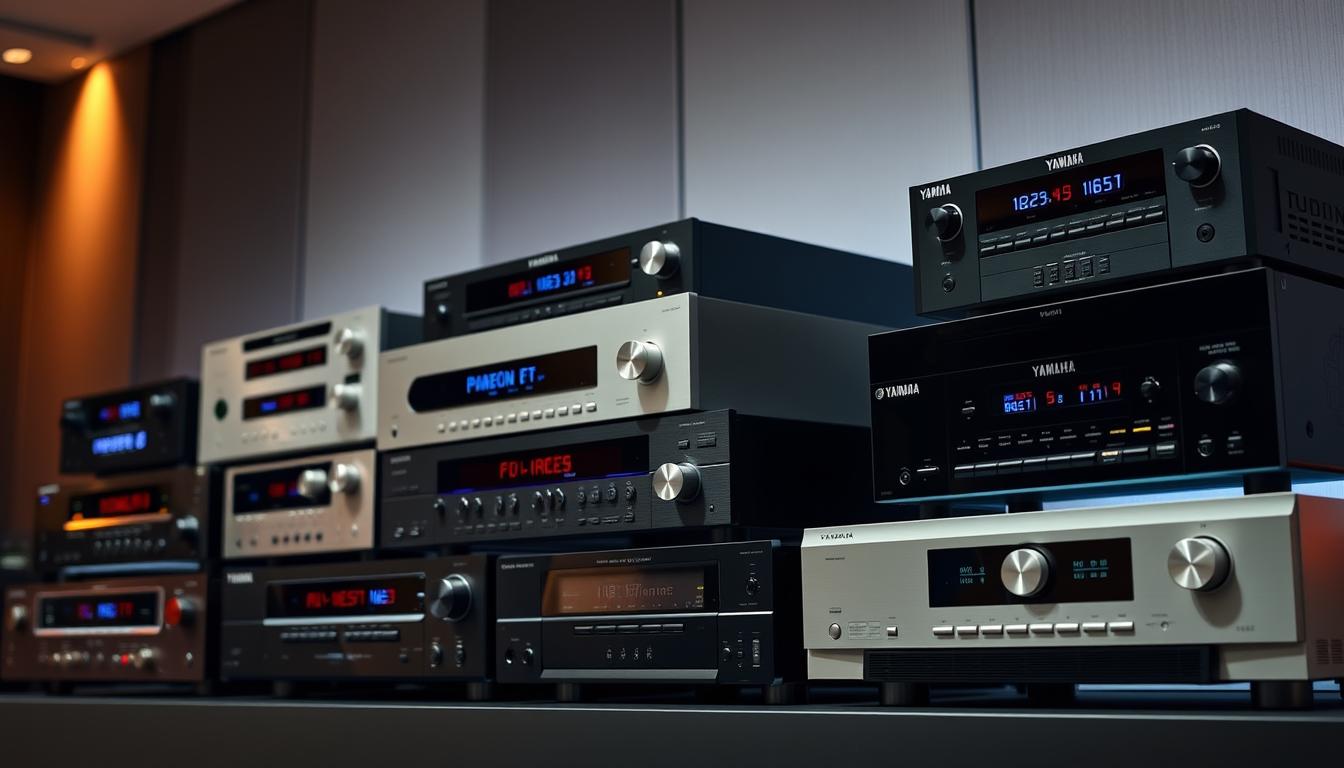
Exploring Yamaha’s audio products, you’ll find many options. From simple yamaha stereo receivers to advanced yamaha audio receivers. Knowing Yamaha’s history helps you choose the best for your home entertainment.
| Product | Year | Notable Features |
|---|---|---|
| Yamaha RX-V850 AV receiver | 1991 | Advanced Digital Sound Field processing |
| Yamaha GT-CD1 CD player | 1991 | Unique chassis design, independent left and right I-PDM system 1-bit DACs |
Early Yamaha Receiver Models (1970s-1980s)
The 1970s and 1980s were key years for Yamaha. They introduced models like the CR-440, CR-500, and CR-800. These showed Yamaha’s focus on innovation and quality.
Some notable models from this era include:
- Yamaha CR-440: Released in 1979
- Yamaha R-500: Released in 1981
- Yamaha CR-800: Made debut in 1974, retailing for $580.00
These early models set the stage for Yamaha’s success in home audio. Their influence is seen in Yamaha’s products today.
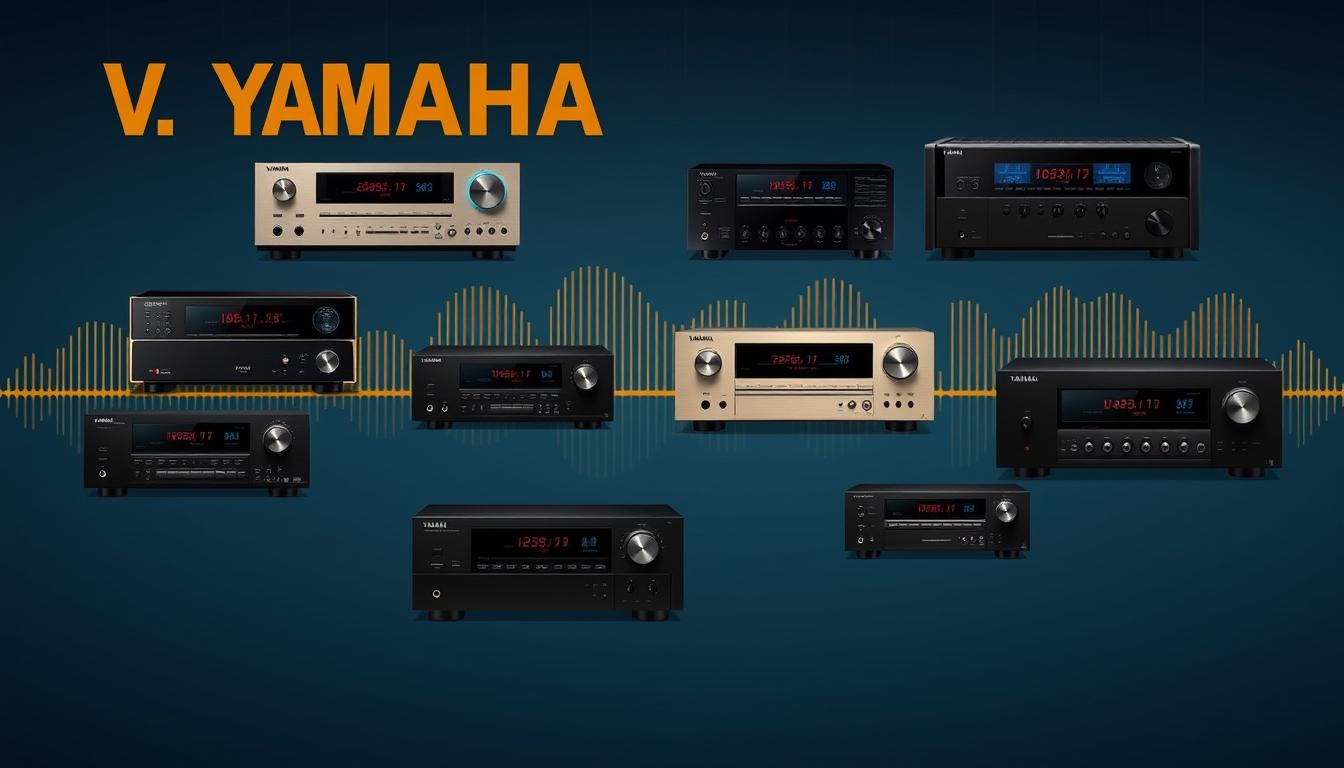
Looking at the yamaha av receiver timeline, it’s clear Yamaha’s early models were important. They focused on quality, innovation, and customer satisfaction. This made Yamaha a leader in the market, and its legacy continues to shape their products.
| Model | Release Year | Retail Price |
|---|---|---|
| Yamaha CR-440 | 1979 | $395.00 |
| Yamaha R-500 | 1981 | $460.00 |
| Yamaha CR-800 | 1974 | $580.00 |
The Digital Revolution: Yamaha Receivers in the 1990s
In the 1990s, Yamaha home theater receivers saw a big change. They started using digital surround sound. This change was huge for home theaters. Models like the RX-A1070 made Yamaha a top name in the field.
These receivers offered strong surround sound and new features. They supported Dolby Atmos and DTS-X. This made home theaters sound better than ever.
First Digital Surround Sound Models
The first digital surround sound models from Yamaha were impressive. They had 110W per channel for 8 ohms and 165W for 1kHz. They also had Wi-Fi, Bluetooth, and MusicCast for easy music streaming.
They had HDMI for 4K Ultra HD and HDR video. This made watching movies and TV shows a great experience.
Breakthrough Features and Technologies
These Yamaha receivers had cool features. They had DAB/DAB+ tuners for clear radio and supported high-resolution audio. They also had YPAO-R.S.C. and YPAO Volume for better sound.
The AVENTAGE series was a big step forward. It showed Yamaha’s commitment to sound quality. It made audio experiences more immersive.
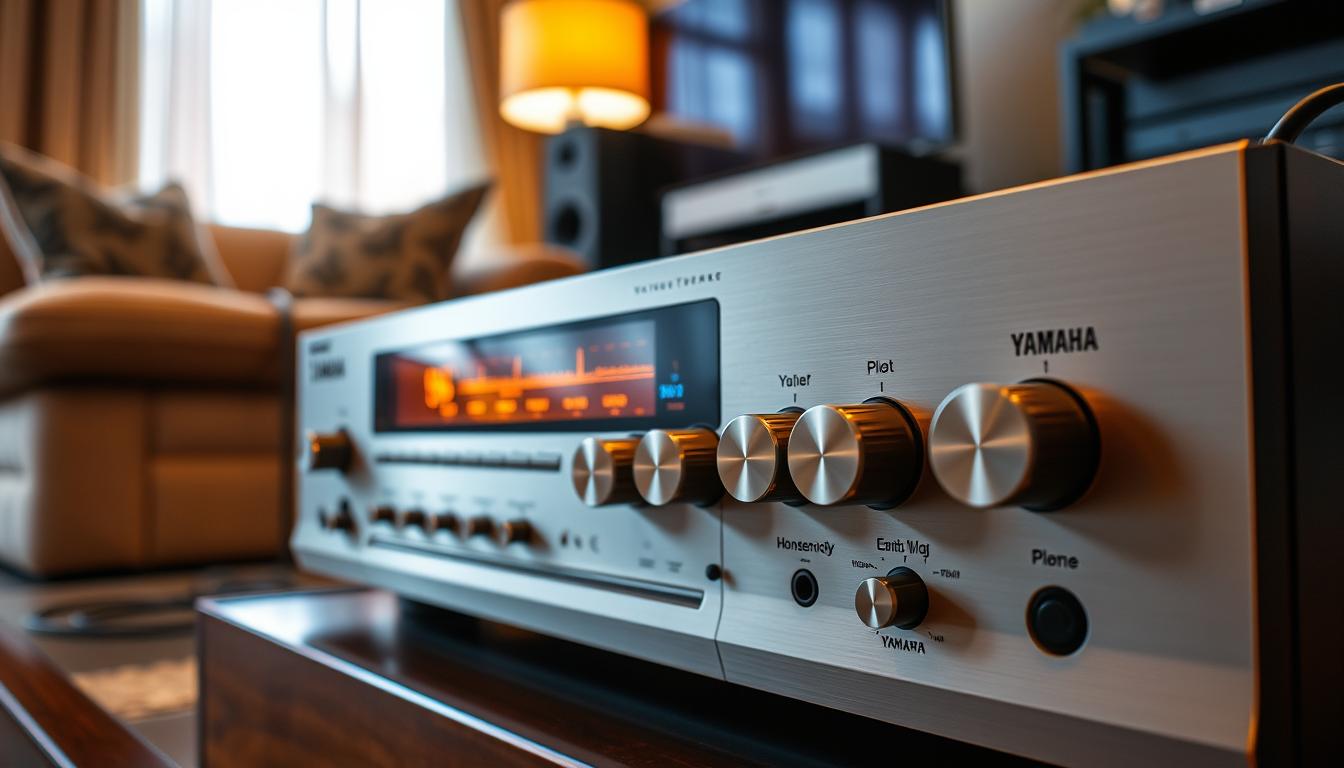
Notable Models from this Era
Here are some key Yamaha home theater receivers from the 1990s:
| Model | Power Output | Features |
|---|---|---|
| RX-A1070 | 110W per channel | Dolby Atmos, DTS-X, Wi-Fi, Bluetooth |
| A-S501 | 85W per channel | YPAO-R.S.C., YPAO Volume, DAB/DAB+ tuner |
These models were a big step for Yamaha. They set the stage for future advancements. They helped make Yamaha a leader in home theater technology.
Yamaha Receiver Models By Year: 2000-2010
Looking at Yamaha receivers from 2000 to 2010 is key. This time had big leaps in home theater tech. Yamaha led with models like the RX-V2600 and RX-Z11.
These receivers brought better surround sound and video switching. The RX-V2600 had advanced audio processing and multi-room capability. The RX-Z11 had high-definition video support and enhanced connectivity options.
Comparing these models shows big gains in sound and features. Here are some key specs:
| Model | Release Year | Surround Sound Capabilities | Video Switching Capabilities |
|---|---|---|---|
| RX-V2600 | 2004 | Dolby Digital 5.1, DTS 5.1 | 3 HDMI inputs, 1 HDMI output |
| RX-Z11 | 2007 | Dolby Digital 7.1, DTS-HD Master Audio | 4 HDMI inputs, 2 HDMI outputs |
When picking a Yamaha receiver, think about your home theater needs. Look at the features and specs of these models. This will help you choose the right receiver for your entertainment.
Modern Era Innovations (2011-2015)
Exploring Yamaha receivers from 2011 to 2015 shows big leaps forward. This time brought network integration, making connections easy. Yamaha receiver reviews from then show how these features improve your home theater.
Advanced room calibration was a big innovation. It lets receivers adjust sound for your room’s acoustics. For more on these features, check out Yamaha receiver reviews and see how they boost your home theater.
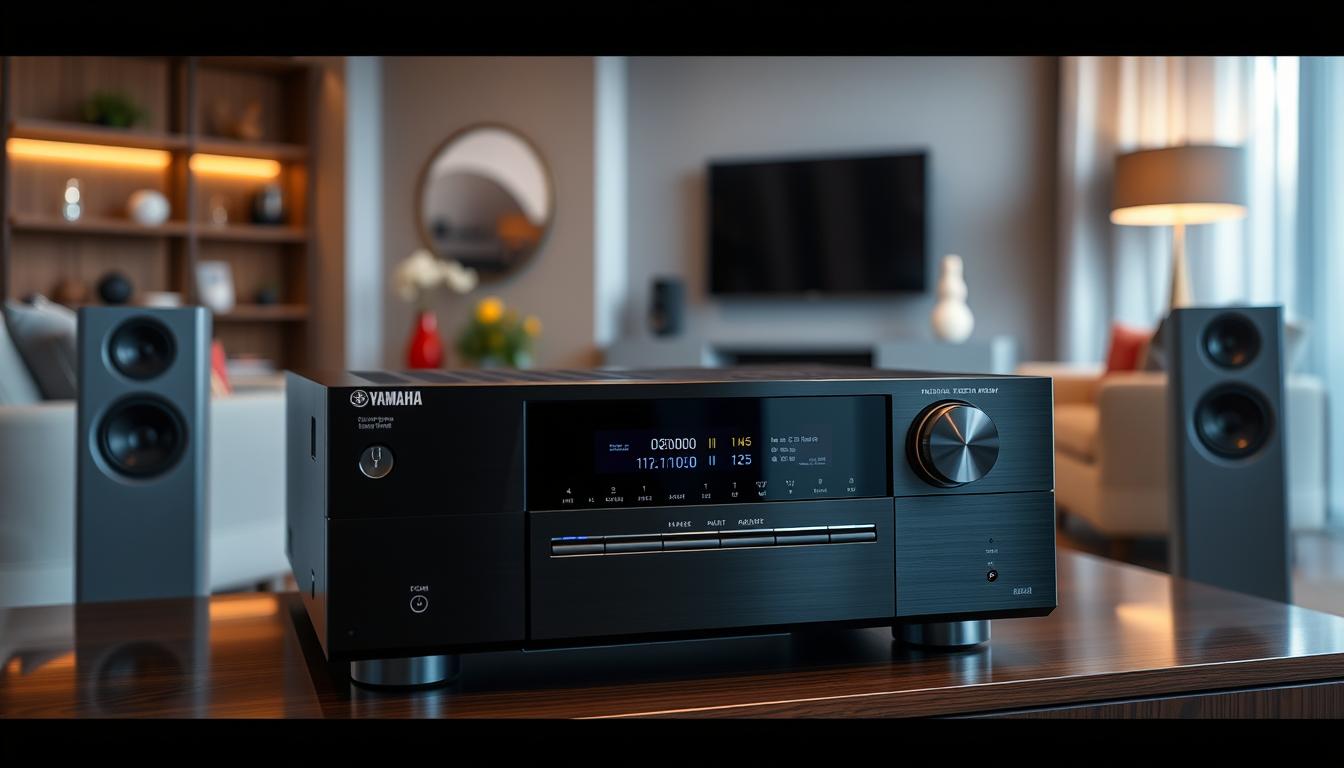
Models from this era support 4K video, Dolby Atmos, and DTS:X. These are key for a great home theater. When picking a Yamaha receiver, think about:
- Network integration features
- Advanced room calibration
- Surround sound capabilities
- Video switching capabilities
Looking at these points and reading yamaha receiver reviews will help you choose the best. This will make your home theater even better.
Latest Generation Receivers (2016-Present)
Yamaha leads in home theater tech, and their latest receivers are top-notch. Models like the RX-V781, RX-V681, RX-V581, and RX-V481 cater to all enthusiasts. They boast features like HDMI 2.0, 4K/60Hz, and HDR pass-through.
These receivers come with exciting features:
- 7.2-channel and 5.1-channel setups
- Support for surround formats like DD/ DD+/AC3/EAC3, DTS, Dolby TrueHD, Dolby Atmos, and DTS-X
- HDCP 2.2 for 4K streaming and Ultra HD Blu-ray players
- Bluetooth with Compressed Music Enhancer for better wireless music
Here’s a look at some of the latest Yamaha receivers:
| Model | Channels | Price |
|---|---|---|
| RX-V781 | 7.2 | $849.95 |
| RX-V681 | 7.2 | $649.95 |
| RX-V581 | 7.2 | $549.95 |
| RX-V481 | 5.1 | $449.95 |
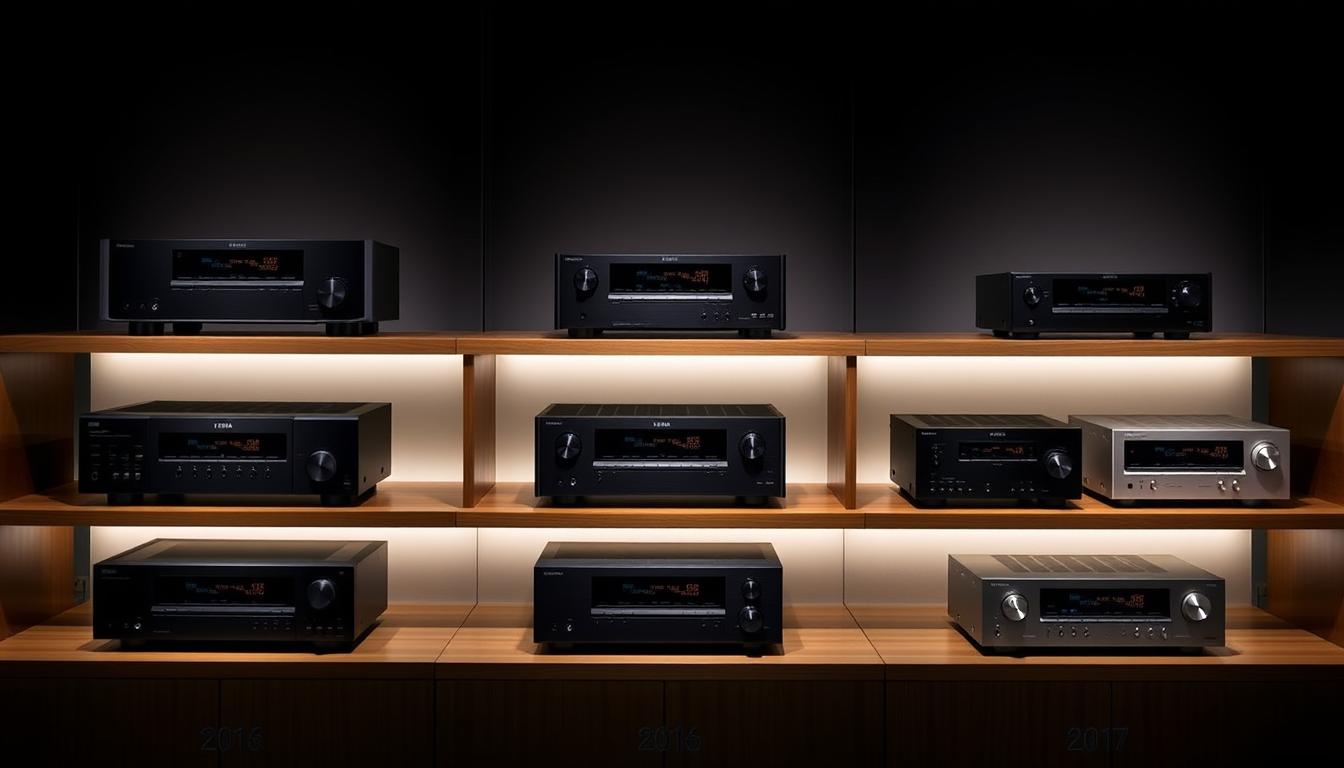
Understanding Yamaha’s Model Naming Convention
When looking at the yamaha av receiver timeline, knowing the model naming convention is key. It helps you find the right receiver for your needs. The convention makes it easy to identify the series, model number, and year of release.
Series Designations Explained
Yamaha’s series designations use letters and numbers. For example, the RX-A series is high-end, while the HTR series is more affordable.
Model Number Meanings
The model number tells you about the receiver’s features. For instance, the Yamaha RX-A2A is a 7.2-channel receiver with 80W/8 Ohm power output.
Year Identification Methods
To find the release year, look at the last two digits of the model number. For example, the Yamaha RX-V6A was released in 2020, shown by “20” in the model number.
Understanding Yamaha’s naming convention helps you choose the right receiver. Whether you want a high-end model or something more affordable, knowing how to read the model number and series designation is essential. It ensures you find the perfect receiver for your home audio needs.
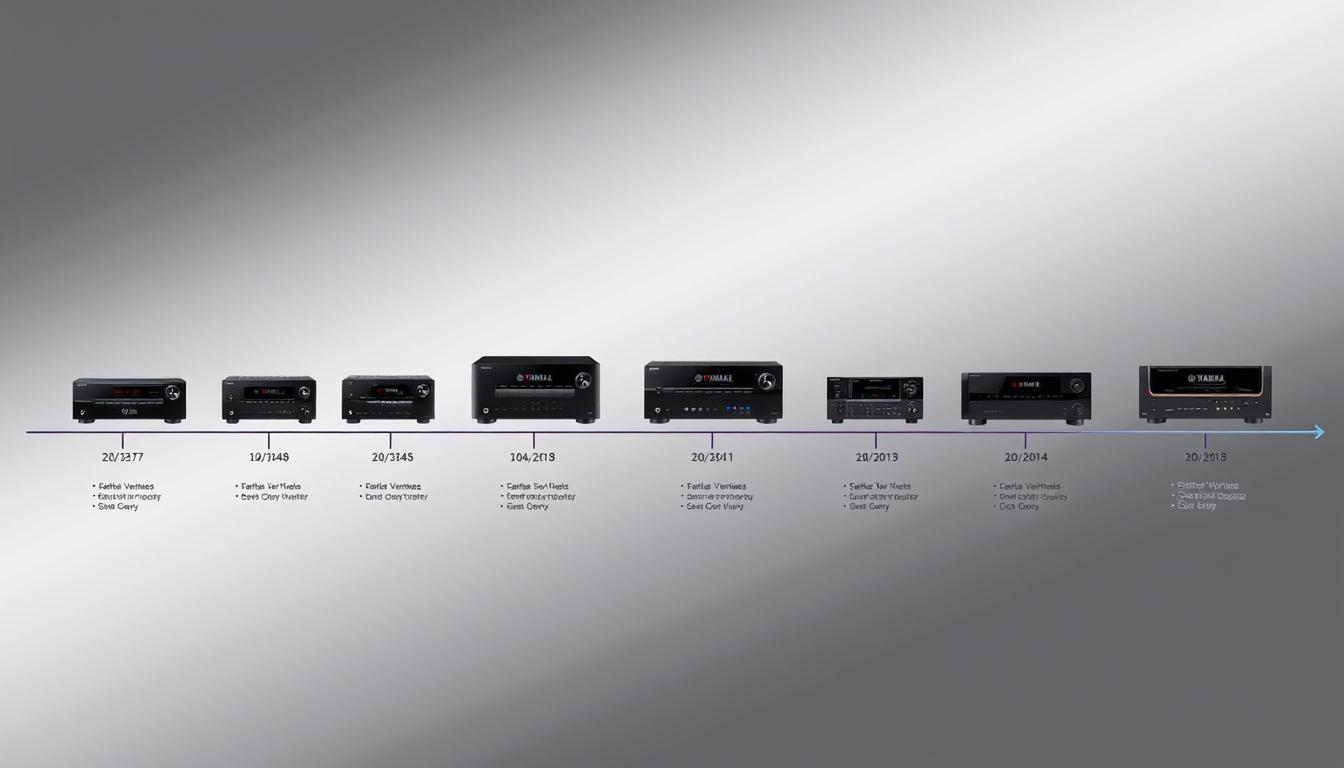
| Model | Channels | Power Output | Year of Release |
|---|---|---|---|
| Yamaha RX-A2A | 7.2 | 80W/8 Ohm | 2020 |
| Yamaha RX-V6A | 7.2 | 100W/8 Ohm | 2020 |
| Yamaha RX-A8A | 11.2 | 150W/8 Ohm | 2020 |
Best-Selling Yamaha Home Theater Receivers
Yamaha home theater receivers are a favorite among those looking for top-notch sound. Models like the Yamaha RX-A4A, RX-V4A, and RX-A8A are highly sought after. They offer features such as 7.1 channels, 110W/8 Ohm power, and connectivity via Bluetooth/Wi-Fi.
Users love these receivers for their ease of use and sound quality. For instance, the Yamaha RX-A6A boasts 9.2 channels, 150W/8 Ohm power, and 7 HDMI in/3 out. You can find more details on yamaha 5.1 channel receiver review pages.
Here are some key features of the best-selling yamaha home theater receivers:
- Yamaha RX-A4A: 7.1 channels, 110W/8 Ohm power output
- Yamaha RX-V4A: 5.2 channels, 80W/6 Ohm power output
- Yamaha RX-A8A: 11.2 channels, 150W/8 Ohm power output
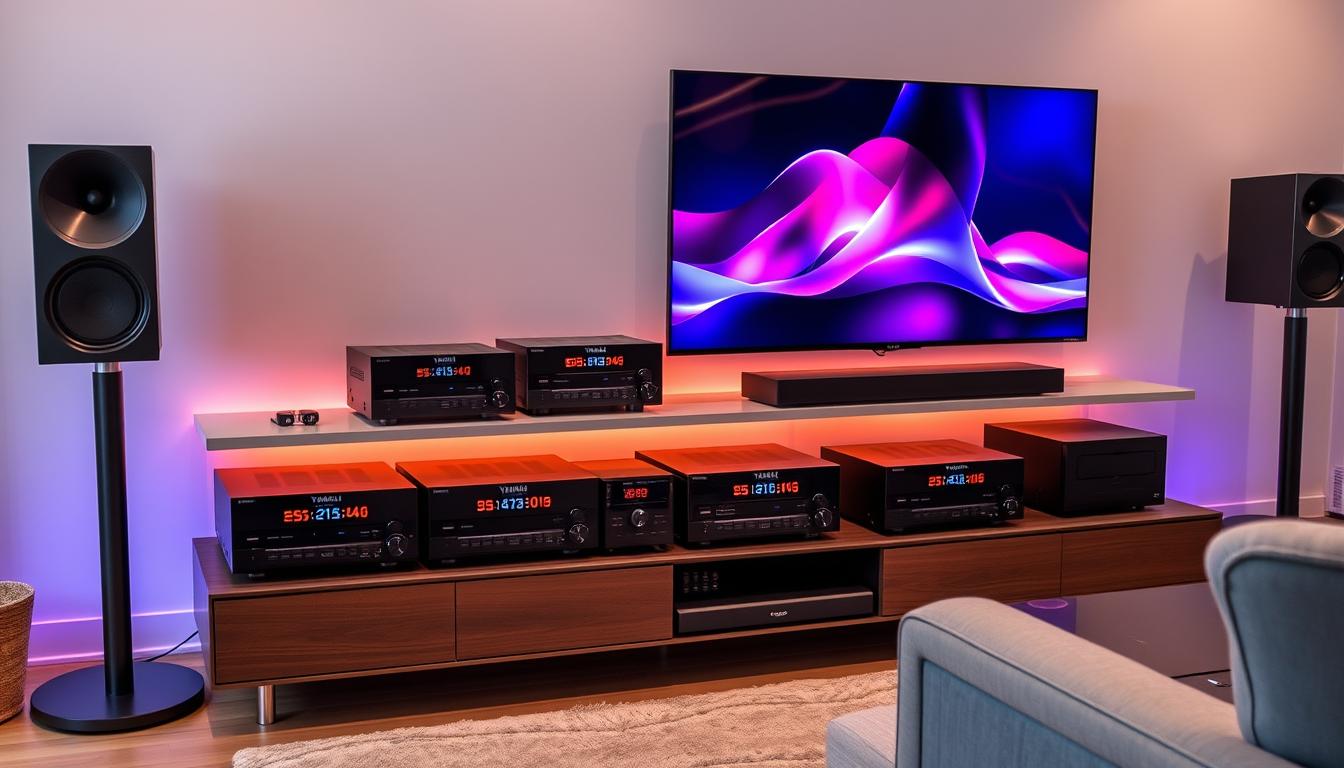
Yamaha home theater receivers are known for their advanced features and superior sound. Whether you’re on a budget or looking for the best, Yamaha has something for everyone.
| Model | Channels | Power Output |
|---|---|---|
| Yamaha RX-A4A | 7.1 | 110W/8 Ohm |
| Yamaha RX-V4A | 5.2 | 80W/6 Ohm |
| Yamaha RX-A8A | 11.2 | 150W/8 Ohm |
Comparing Yamaha Stereo vs. AV Receivers
Choosing the right receiver for your home audio system can be tough. You’ll find two main options: yamaha stereo receivers and AV receivers. It’s important to know the differences to make a good choice. Think about what matters to you, like the number of channels, HDMI inputs, and room correction.
Yamaha stereo receivers are great for a simple, two-channel music setup. AV receivers, on the other hand, are perfect for home theaters. They have more channels, advanced audio, and video features. For example, if you want a 5.1-channel surround sound system, an AV receiver is better.
Feature Differences
When comparing yamaha stereo receivers and AV receivers, look at channels, power output, and connectivity. AV receivers usually have more channels, higher power, and features like Dolby Atmos and DTS:X. Yamaha stereo receivers focus on high-quality, two-channel audio. They also have Bluetooth and MusicCast support.
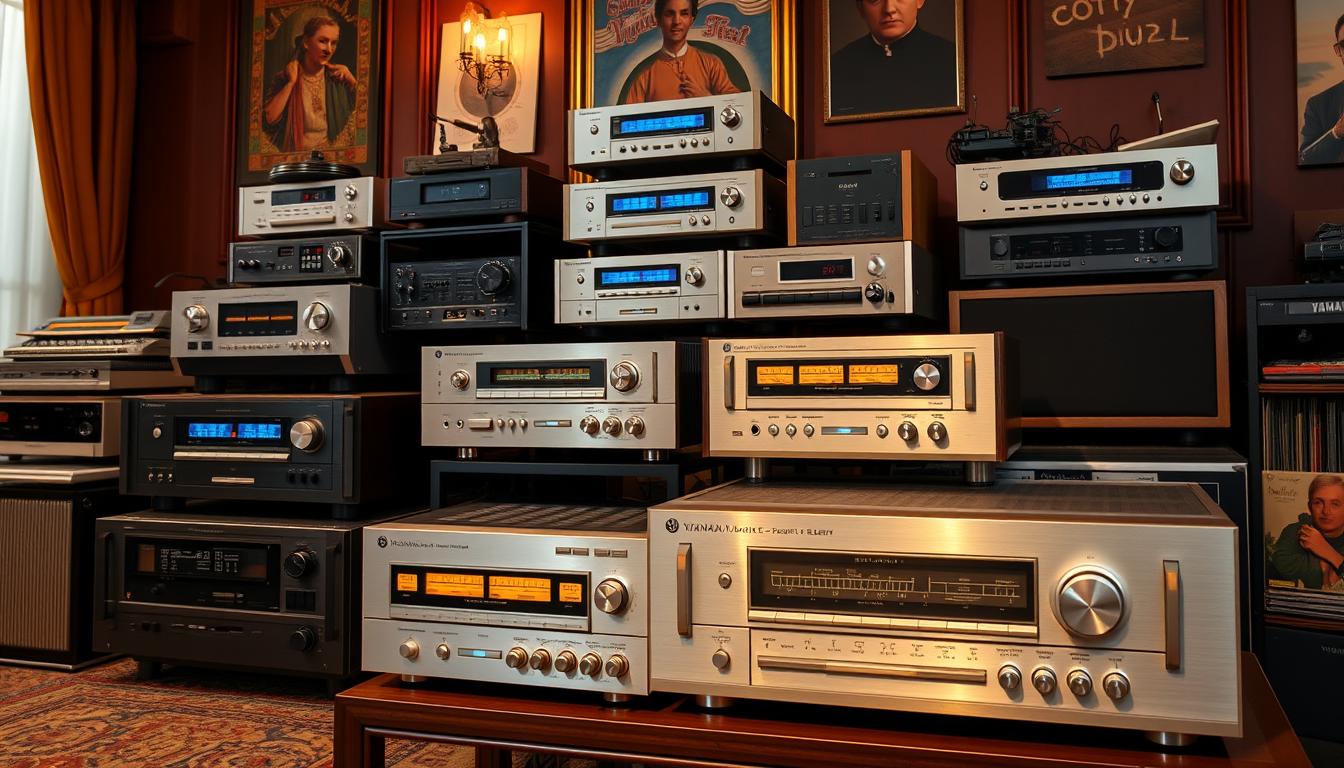
Use Case Scenarios
Think about how you’ll use the receiver. If you love music and want a simple, high-quality setup, a yamaha stereo receiver is good. But, if you want a home theater with many channels and advanced audio, an AV receiver is better.
Price Range Comparison
Prices for yamaha stereo receivers and AV receivers vary a lot. Yamaha stereo receivers start at around $200-$300. AV receivers can cost from $500 to $2,000 or more, depending on the features and quality.
Key Technologies in Modern Yamaha Receivers
Exploring yamaha receiver models by year shows how technology has changed home theaters. New surround sound and video switching features have made a big difference. For example, most Yamaha receivers from 2015 to 2019 support 4K Ultra HD, with 3840 x 2160 pixels.
Modern Yamaha receivers come with cool features:
- They support HDMI 2.1, which handles 8K at 7680 x 4320 pixels
- Surround:AI analyzes movie scenes five times per second
- ARC and eARC for easy audio transmission
- They also support HDR formats like Dolby Vision and Hybrid Log-Gamma for better picture quality
Yamaha offers affordable A/V receivers like the RX-V757 and RX-V457. These models have various features and prices. With yamaha receiver models by year always changing, it’s important to keep up with new tech.
Knowing these technologies helps you choose the right Yamaha receiver. It will improve your home theater experience.
| Model | Channels | Power Output |
|---|---|---|
| Yamaha RX-V6A | 7.2-channel | 100 Watts at 8 Ohm |
| Yamaha RX-A6A | 9.2-channel | 150 Watts at 8 Ohm |
| Yamaha RX-V385 | 5.1-channel | 100W at 8 Ohm, 145W at 6 Ohm |
How to Choose the Right Yamaha Receiver
Choosing a Yamaha receiver involves several key factors. These include room size, budget, and what features you need. A yamaha receiver comparison can guide you. For instance, the Yamaha RX-V385, RX-V4A, and RX-V6A models differ in connectivity and power. They suit various room sizes and audio setups.
Think about how many channels and speakers you need. The RX-V385 has 5.1 channels, while the RX-V6A has 7.2. Also, consider the devices you’ll connect, like Blu-ray players and streaming devices. The RX-V4A and RX-V6A support wireless streaming via Wi-Fi, AirPlay 2, and Bluetooth.
Yamaha receivers vary in price, from a few hundred to several thousand dollars. The RX-V385 is more budget-friendly, while the RX-V6A is pricier with features like Dolby Atmos and DTS:X. By matching your budget and needs, you’ll find the ideal Yamaha receiver. This will enhance your home theater experience with movies and music.
Important features to look for in a Yamaha receiver include:
- Number of channels and speakers
- Connectivity options (HDMI, Wi-Fi, Bluetooth, etc.)
- Power output and audio quality
- Support for surround sound formats (Dolby Atmos, DTS:X, etc.)
- Wireless streaming options and voice control
By considering these factors and your specific needs, you can choose the right Yamaha receiver. This will make your yamaha receiver comparison successful.
Premium vs. Entry-Level Models
When looking at yamaha receiver reviews, it’s key to understand the difference between premium and entry-level models. Premium models, like the Aventage series, have top-notch features. These include 8K@60Hz/4K@120Hz support, Dolby Atmos, and DTS:X audio. They also have high-quality components for better sound.
On the other hand, entry-level models, like the RX-V375, are more affordable. They have fewer features and less power. Yet, they include important features like HDMI 1.4 inputs and Yamaha’s YPAO room calibration system. Surround: AI tech is also found in some entry-level models, improving the sound.
When deciding between premium and entry-level models, consider these points:
- Number of HDMI inputs and outputs
- Support for 4K/Ultra HD and 8K resolution
- Power output per channel
- Room calibration capabilities
- Network-enabled features like AirPlay and Pandora
The choice between premium and entry-level models depends on your needs and budget. If you want the best audio experience with advanced features, go for premium. But if you’re on a budget or just starting your home theater, an entry-level model is a great value.
Conclusion
Throughout this detailed look at Yamaha receiver models by year, we’ve seen the brand’s commitment to innovation and quality. From the early days of the 1970s and 1980s to today’s digital advancements, Yamaha has always led in home audio technology.
Looking for a basic home theater receiver or something more advanced? Knowing Yamaha’s wide range of products is key to choosing the right one. Consider your room size, budget, and what features you need. This way, you can pick the perfect Yamaha receiver to enhance your home audio.
Starting your search for a Yamaha receiver? Remember, the brand’s dedication to quality and innovation is in every model. With a history of groundbreaking tech and a focus on audio excellence, Yamaha remains a top choice for home theater fans and audiophiles. Dive into the Yamaha legacy and enjoy the unmatched sound that has shaped the brand for years.
FAQ
What is the history of Yamaha’s audio products?
Yamaha has a long history in audio technology. They started with big innovations. Their work in surround sound and high-quality audio receivers has changed home audio.
What were some of Yamaha’s early receiver models?
Yamaha’s first receivers, like the RX-V850 and RX-V1050, brought surround sound to homes. This had a big impact on home audio.
How did Yamaha’s receivers evolve in the digital era?
Yamaha’s digital era brought advanced surround sound models. These models also improved video switching and changed home theaters.
What Yamaha receiver models were popular in the 2000-2010 era?
In the 2000-2010 era, Yamaha’s RX-V2600 and RX-Z11 models were hits. They pushed the limits of surround sound and video, making Yamaha a top choice for home theaters.
What are the key features and innovations in Yamaha’s modern receivers?
Yamaha’s latest receivers have new technologies. They include network integration and advanced room calibration. These features enhance the home theater experience.
How can I understand Yamaha’s model naming convention?
Yamaha’s naming system helps you find the right receiver. It includes series names, model numbers, and year codes. Knowing this helps you make a smart choice.
What are Yamaha’s best-selling home theater receivers?
Yamaha’s top receivers are loved for their features and impact on home theaters. They offer advanced specs and capabilities.
What are the key differences between Yamaha’s stereo and AV receivers?
Yamaha’s stereo and AV receivers have different features. Knowing these differences helps you choose the right one for your needs and budget.
What are the latest technologies in Yamaha receivers?
Yamaha’s latest receivers have cutting-edge surround sound and video. These advancements have greatly influenced home theaters.
How can I choose the right Yamaha receiver for my needs?
Consider your room size, budget, and what you need when picking a Yamaha receiver. This ensures a great home theater experience.
What are the differences between premium and entry-level Yamaha receiver models?
Premium and entry-level Yamaha receivers differ in features and price. Knowing these differences helps you choose based on your needs and budget.


